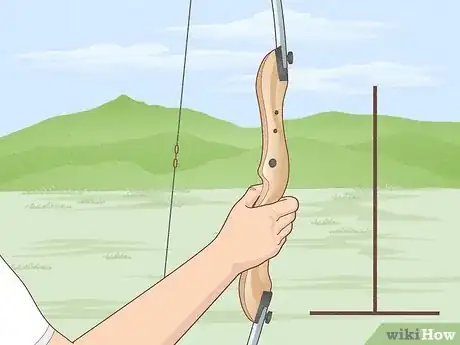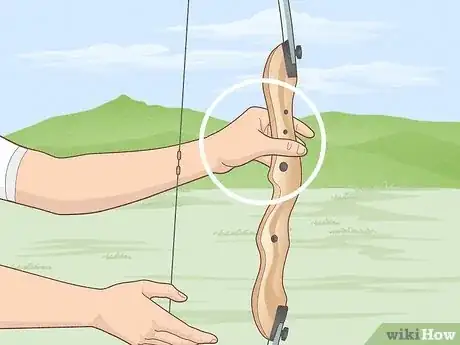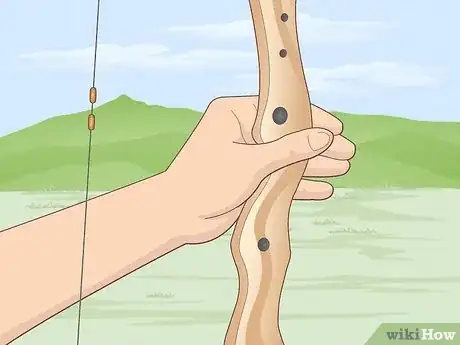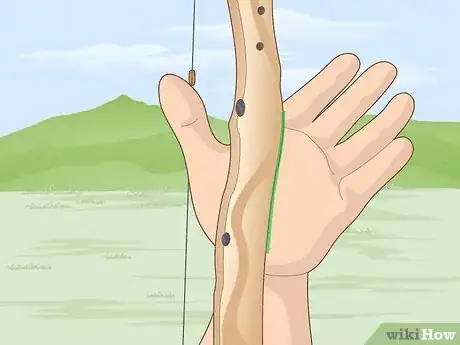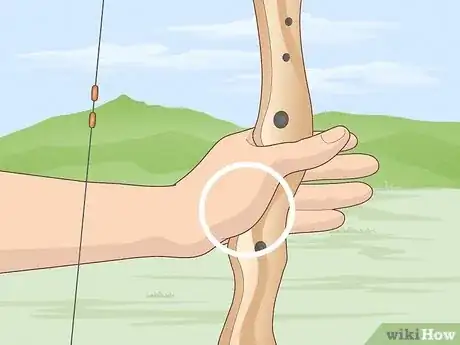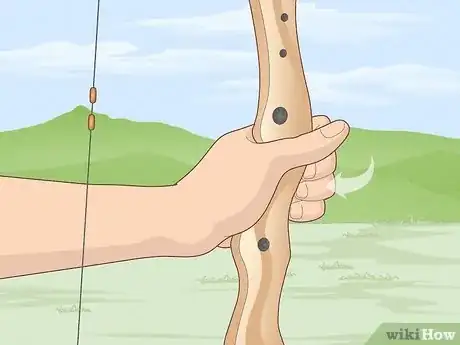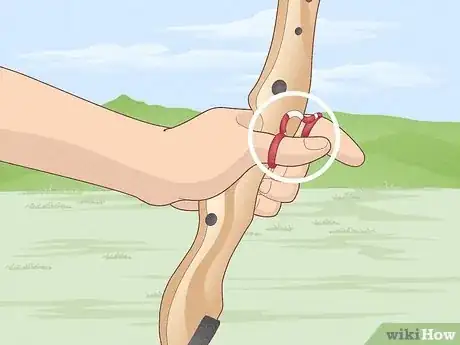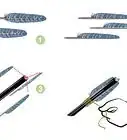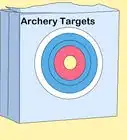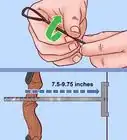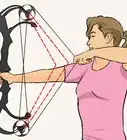This article was co-authored by wikiHow staff writer, Glenn Carreau. Glenn Carreau is a wikiHow Staff Writer, currently based in Los Angeles. With over four years of experience writing for several online publications, she has covered topics ranging from world history to the entertainment industry. Glenn graduated with honors from Columbia College Chicago, earning a B.A. in Interactive Arts and Media and a minor in Professional Writing. Today, Glenn continues to feed her lifelong love of learning while serving wikiHow's many readers.
There are 7 references cited in this article, which can be found at the bottom of the page.
This article has been viewed 81,967 times.
Learn more...
Are you hoping to hone your archery talents but aren't sure of the right way to hold your bow? You're not alone. There are many misconceptions about bow grip, and we're here to clear them up. Developing a proper archery grip is pretty simple, yet it has a considerable effect on your ability to shoot arrows! Read on for a comprehensive guide to holding an archery bow.
Steps
Hold the bow perpendicular to the ground.
-
Set up your grip while holding up the bow to avoid straining your hand. Pick up your bow and hold it upright. The bow should line up vertically with the strings, and the entire thing should face the ground at roughly a 90-degree angle. Settling into a grip and pulling back the bowstring before you hold up the bow can put extra strain on you. Wait until the bow is raised to finalize your grip![1] X Research source
- Resist the urge to "shake hands" with your bow. In other words, don't grasp it directly from a straight angle, as this can put your hand off-center with the grip.
Grasp the bow in your non-dominant hand.
-
You need your stronger dominant hand to hold and aim the arrow. This might seem counter-intuitive, but your dominant hand should be the one gripping and aiming the arrow—while your non-dominant hand holds the bow. Your grip on the bow will be light, so you don't need your dominant arm to hold it up properly.[2] X Research source
- A lot of strength and power goes into pulling back the arrow, aiming, and firing. Your dominant hand is much better suited to it than your non-dominant hand.
Relax your hand and place it onto the grip.
-
Slide your hand forward on the grip as far as it’ll go to get in position. A bow grip is very helpful because it's designed to guide your hand into position. Simply slide your hand forward with your thumb on one side of the bow and your other fingers on the opposite side. Keep sliding your hand until you can't move it any further and the bow makes contact with the ball of your thumb joint.[3] X Research source
- The goal is to hold your bow in a way that creates the least amount of torque possible. Torque is a force that causes an object to rotate on an axis—and when you shoot an arrow, too much torque can throw off your aim.
- The best way to reduce torque is simply through a light grip on your bow. That's why keeping your hand relaxed is so important as you maneuver it into position.
- The ball of your thumb joint is located at the base of your thumb. As long as your hand is relaxed when you slide it forward, you'll naturally make contact with the bow in the right spot!
Line up the edge of the grip with your lifeline.
-
Your lifeline's ridge is a handy guide to making your grip more precise. First, find your lifeline on your palm—it’s the crease that curves around your thumb at the bottom center of your palm. Then, adjust your grip on the bow so that your lifeline and the edge of the bow grip match up. Keep the bow grip nestled snugly in the V-shaped pocket between your thumb and index finger.[4] X Research source
- Try placing a piece of tape over your palm's lifeline before gripping the bow, so you can feel the spot where your hand and bow should connect.
- If you grab the bow grip with any other part of your hand, your hand will likely change position once you apply pressure.
- If you can’t feel the V-shaped pocket, you might be forcing your fingers open too wide. This causes the muscles in your palm to stretch and tense up, making the pocket disappear.
Align your thumb with the inner edge of the bow grip.
-
Point your thumb towards the target to help you aim. Rather than curling your thumb, keep it straight as you position it on the other side of the bow, apart from your other fingers. Let it rest very slightly along the inside edge of the bow grip. After you get your thumb in place, adjust it so that it's straight and pointed in the direction of your target.[5] X Research source
Position your thumb pad against the bow grip.
-
Your palm's position on the bow's grip greatly affects accuracy. Angle your palm slightly downward to press your palm's pivot (the spot right where your thumb and index finger intersect) and pressure points (the area of your thumb pad directly below your pivot point) against the bow grip. Remember: your entire palm shouldn't press on the grip—just your thumb pad.[6] X Research source
- Once your palm is settled, see if you can draw a straight line from your pivot point down to the bottom of your thumb pad where your hand is touching the bow. If you can, your hand is in the right spot!
Position your knuckles at a 45-degree angle to the bow.
-
This grip is helpful if you struggle with holding the bow too tightly. Rather than wrapping all your fingers around the front of the bow, as you might naturally do, pull your index, middle, ring, and pinky fingers back and let them rest gently against the side of the grip, moving down diagonally at a 45-degree angle from the bow. Keep your thumb resting normally on the other side of the bow.[7] X Research source
- Because your fingers don't wrap around the bow with this grip, it's good training to help you maintain a relaxed grip as you draw and shoot.
- Place the force of the bow mainly on your thumb and index finger; they should feel firm but not tense. These two fingers are the only ones that really end up controlling the direction of the bow.
Gently lay your fingers on the front of the bow, instead.
-
Use this grip if you can bend your fingers on the bow without squeezing. Wrap your index finger around the front of the bow, so it barely meets your thumb from the other side. Curl your other 3 fingers around the front of the bow, but don't squeeze or grip the bow too tightly.[8] X Research source Let your finger grip feel comfortable and natural as you hold the bow.
- You may need to play around with finger placement to find something firm and comfortable, but as with other bow types, most control will still come from the thumb and index finger.
- If your thumb and index finger press tightly together, you may end up strangling the bow—which causes hand pain and interferes with the accuracy of your shot.
- You can absolutely wrap your fingers around the front of your bow, but you may find it easier to pull your fingers back at a 45-degree angle (as demonstrated in the previous step) if you tend to squeeze the bow.
Maintain a relaxed grip on the bow.
-
Keep your fingers in the same place as you draw and release the bow. When you shoot an arrow, let all the tension exist in your hand while your wrist, arm, and shoulder stay relaxed. Ensure the left part of your palm doesn't touch the grip part of the bow as you draw and release, either. Keep it facing downward toward the ground when you make your shot.[9] X Research source
- Test your grip by trying to wiggle your fingers when your bow is fully drawn. If you can wiggle them, you have a properly relaxed grip.
- If your palm touches the bow (beyond your lifeline and thumb pad), you will be unable to turn the bow arm inward, which can lead to a bad shot.
- Rest all the pressure on the ball of your thumb as you shoot, keeping your wrist as straight as possible.
Use your dominant hand to hold and shoot an arrow.
-
Nock an arrow in your bow and grip it firmly with three fingers. To properly hold an arrow, start by placing it at your bow’s nocking point, which is typically either a brass or rubber ring or a marked spot on your bowstring. Then, grip the tail end of the arrow by positioning your index finger above it and your middle and ring fingers below, getting a firm hold without squeezing the arrow too tightly.[10] X Research source
- To shoot the arrow, pull back the bowstring while gripping the arrow in your fingers until your hand rests next to your face. Aim the bow, then release the bowstring and let your arrow fly.
- Relax your fingers smoothly and quickly once you feel confident with your aim. There’s no need to tense up at any point in the shooting process!
Use a finger sling on your bow.
-
A finger sling holds the bow in place after you shoot an arrow. Since your hold on the bow will be extremely light, a finger sling can do the heavy lifting, so your bow doesn't fall after shooting. Get a finger sling and pull one loop over your index or middle finger. Then, pull the sling around the grip of your bow and pull the other loop onto your thumb, holding your bow in place.[11] X Research source
- You can also make a homemade finger sling out of a shoelace if you prefer.
Community Q&A
-
QuestionHow do I hold the arrow?
 Community AnswerYou don't. Just hold the handle and put the arrow in its holder and clip it to the straight string in front of the loop. If you have a release, clip that onto the loop itself. Then pull the latch on the release, or use your fingers and let go. (Assuming you have a compound bow.)
Community AnswerYou don't. Just hold the handle and put the arrow in its holder and clip it to the straight string in front of the loop. If you have a release, clip that onto the loop itself. Then pull the latch on the release, or use your fingers and let go. (Assuming you have a compound bow.) -
QuestionI am ambidextrous. Which hand do I use?
 Community AnswerIt depends on whether or not your bow is a left or right handed bow. If it doesn’t make a difference, then choose whichever side is more comfortable. I would suggest to use your left hand on the grip on the bow because most bows are made for that hand—I would say the majority of the population is right handed, and in some countries the left hand is “unholy.”
Community AnswerIt depends on whether or not your bow is a left or right handed bow. If it doesn’t make a difference, then choose whichever side is more comfortable. I would suggest to use your left hand on the grip on the bow because most bows are made for that hand—I would say the majority of the population is right handed, and in some countries the left hand is “unholy.”
You Might Also Like
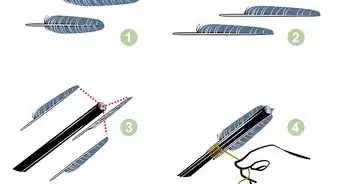
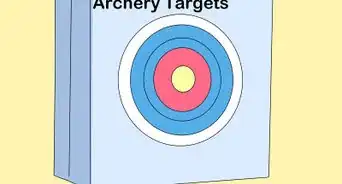
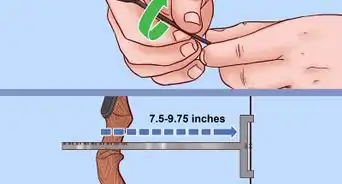
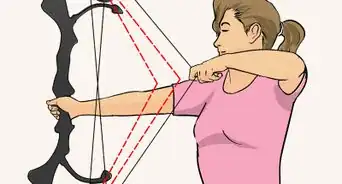

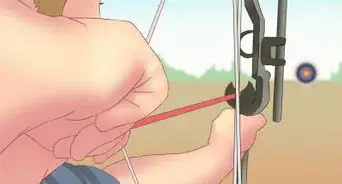



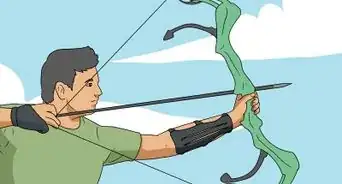
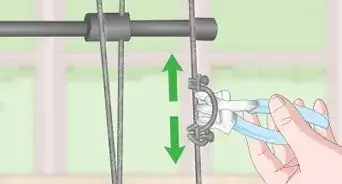

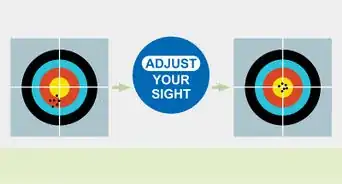
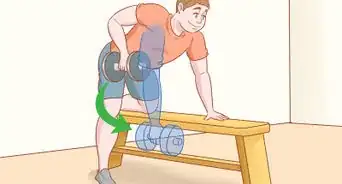
References
- ↑ https://legendarchery.com/blogs/archery-bowhunting-blog/115639172-easy-ways-to-grip-your-compound-bow-properly
- ↑ https://archeryforbeginners.com/blog/left-or-right-hand-bow/
- ↑ https://archery360.com/2019/05/08/form-breakdown-grip/
- ↑ https://archery360.com/2019/05/08/form-breakdown-grip/
- ↑ https://archery360.com/2019/05/08/form-breakdown-grip/
- ↑ https://archery360.com/2019/05/08/form-breakdown-grip/
- ↑ https://archery360.com/2019/05/08/form-breakdown-grip/
- ↑ https://youtu.be/fN2wTXMWCH0?t=237
- ↑ https://www.mossyoak.com/our-obsession/blogs/how-to/10-archery-tips-from-11-time-repeat-asa-shooter-of-the-year-levi-morgan
About This Article

